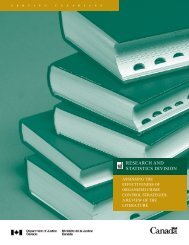National Threat Assessment 2008. Organised Crime - Politie
National Threat Assessment 2008. Organised Crime - Politie
National Threat Assessment 2008. Organised Crime - Politie
You also want an ePaper? Increase the reach of your titles
YUMPU automatically turns print PDFs into web optimized ePapers that Google loves.
An important indicator of heroin production is the presence of laboratories.<br />
Mainly morphine laboratories were found during criminal investigations in<br />
Afghanistan; the number of heroin laboratories was smaller. This might suggest<br />
that most of the opium in Afghanistan is only converted into morphine and that<br />
it is converted into heroin elsewhere. In principle, heroin can be produced<br />
anywhere in the countries along the smuggling routes from Afghanistan to<br />
Western Europe. In practice, it will mainly be produced at locations where<br />
AA is available or where the risks attached to conversion are smaller.<br />
It is estimated that 25% of all the opiates produced worldwide were seized<br />
in 2006. However, this has apparently not affected the prices or the purity of<br />
opiates on the Western European markets. The assumption is therefore that<br />
opium produced and stored previously has been used to balance out the<br />
‘shortage’. Little is known about opium storage locations. The shelf life of<br />
opium is several years.<br />
Smuggling<br />
Two major smuggling routes run from Afghanistan to Europe: the Northern<br />
Route and the Southern Route. The Northern Route runs from Afghanistan via<br />
the countries of Central Asia and Kazakhstan to the Russian Federation and on<br />
to Europe. The Southern Route runs from Afghanistan to Iran (sometimes via<br />
Pakistan) and then through Turkey to join up with the various Balkan routes.<br />
According to the Turkish authorities, this Southern Route has had a branch for<br />
a number of years, whereby the route from Iran no longer runs to Turkey, but<br />
veers to the north and runs through the countries next to the Black Sea or even<br />
crosses the Black Sea. This is known as the ‘Northern Black Sea Route’. In Europe<br />
this route runs through Romania and/or Bulgaria to join up with the usual Balkan<br />
routes. Romania and Bulgaria have formed the external border of the European<br />
Union since 1 January 2007. As a result, Romania and Bulgaria have become even<br />
more appealing to smugglers as transit countries. The Netherlands plays a role in<br />
the distribution of heroin, especially to the UK, France, Spain and Portugal.<br />
The smuggling method depends greatly on the criminal group involved. Turkish<br />
criminal organisations, for example, appear to smuggle heroin primarily over<br />
land via the Balkan routes, where they sometimes outsource the transport to<br />
‘Balkan criminals’. In addition, shipments are also transported by sea from<br />
South-West Asia, but less is known about these transports. Smuggling from<br />
Turkey by air couriers is called the ‘Balkan Route by Air’. The number of couriers<br />
arrested at Schiphol has increased, and so has the amount of heroin smuggled.<br />
Pakistani criminals seem to be smuggling heroin directly from Pakistan using<br />
air couriers.<br />
38 <strong>National</strong> <strong>Threat</strong> <strong>Assessment</strong> 2008 – <strong>Organised</strong> crime








